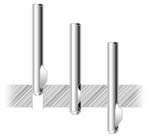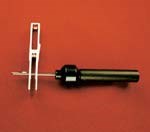New Tools Automate Hole-Deburring
New tools increase the efficiency of automatic hole deburring. Some can handle holes as small as 0.030 inch diameter.
Since the first drill penetrated a piece of metal, deburring holes has represented a necessary additional step in the machining process. Essentially, removing a burr involves cutting a small chamfer on the edge of a hole to remove the metal ridge that remains after a drilling operation. Although this can be performed by hand using a file or burr knife, manual deburring involves substantial time and labor.
As machine shops become more process oriented, an important goal is to eliminate secondary operations. Hole-deburring is one area where manufacturers can save time without making a big investment in capital equipment. Like a cutting tool, a deburring tool can be used much more efficiently when it's loaded into the ATC of a machining or turning center. By allocating a station in the tool magazine for a deburring tool, the operator can reduce cycle times and production costs. Instead of moving workpieces to the bench for handwork, the machine completes deburring automatically.
Featured Content
In-process deburring is a fairly simple idea that allows a machining center to complete holes in a single setup. Although automatic deburring slightly increases the machine's cycle time, it offsets this extra time by eliminating the substantial chore of hand deburring. Additionally, hole-to-hole consistency is much better than that possible when deburring manually.
Double-acting deburring tools have existed for many years. Although several different tool designs are available, all share the same basic concept. These tools incorporate an arbor and a spring-loaded cutting blade that protrudes outside its circumference. When used on through-holes, the tool breaks the top edge of the hole as it enters and breaks the back edge as it exits the workpiece. During this operation, the cutting blade compresses inside the bore and adjusts to its taper.
In the past, double-acting deburring tools have been available only for relatively large bore sizes. Deburring small holes was previously deemed to be impractical because of the problems involved in manufacturing tools strong enough to do the job, but small enough to fit into the holes. Additionally, the manufacturing technology necessary to downsize these tools was not formerly available.
E-Z Burr Tool Company (Plymouth, Michigan) addressed this problem by using new micro-machining techniques to manufacture these small tools. The company includes a group of small deburring tools known as the "micro series" in its product line. These tools can deburr holes as small as 0.030-inch diameter. Recently, this line of tools was redesigned to incorporate a holder with a replaceable blade cartridge. When the blade dulls, the operator simply removes the cartridge and inserts a new one. This eliminates the extra time and other problems associated with separate, miniature blades, arbors and setscrews.
Like many double-acting deburring tools, the micro series can deburr both sides of a through-hole. It's designed with a single, flexible blade that retracts into the arbor to adjust to the hole's diameter. As the rotating tool enters a drilled hole, the blade's tapered cutting edge breaks the corner of the hole, thus removing any burrs. As the tool is fed farther into the bore, the hole's taper acts as a wedge, pushing the blade back into the arbor.
The blade's outside cutting edge incorporates a radius that prevents damage to the hole's surface as the tool passes through the finished bore. Without reversing the spindle's rotation or dwelling, the tool deburrs the backside of the hole when it is withdrawn by simply reversing the Z-axis feed direction.
Throughput is a driving force in the manufacturing business. Getting work out the door as quickly as possible while minimizing costs associated with non value-added labor often represents the difference between profit and loss. Consequently, it makes good sense to perform as many operations as possible in a single setup. Thus, automated deburring tools represent an additional means of reducing manufacturing costs. When employed as an automatic function in the overall machining process, hole-deburring no longer represents a production bottleneck.
RELATED CONTENT
-
Smart Workholding Device Measures and Monitors
Sensor and IIoT technology combine to enable these chucks and mandrels to automatically monitor workholding parameters and measure part features to ensure process stability.
-
Choosing an Automatic Bar Feeder
The bar feeder is the most common form of automation for turning operations. Selecting the right one requires consideration of the applications for which it will be used.
-
Bar Feeder Basics
Some primary factors are often overlooked when considering how to justify the implementation of a bar feeder for turning operations.







